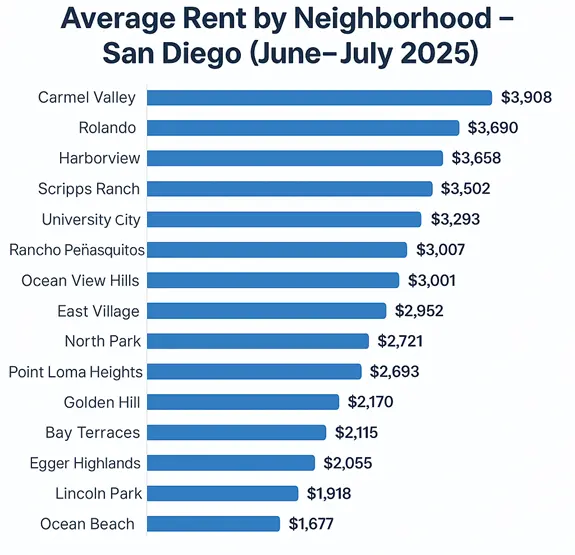Cost of Living in San Diego – How Expensive Is It Really?
Wondering what it really costs to live in San Diego? We break down rent, utilities, groceries, healthcare, taxes, and more using real local data—with minimal fluff and clear visuals.

Cost of living refers to what it takes to afford basics like housing, food, utilities, transportation, healthcare, and taxes, in a particular place. San Diego’s cost-of-living index is significantly above the U.S. average, influencing whether your income can keep up. This guide shows you exactly what to expect in 2025.
Table of Contents
- What Is Cost of Living and Why It Matters in San Diego
- Is San Diego Expensive? 2025 Cost Index vs National Average
- Average Rent & Housing Costs in San Diego: Studio to 3-Bedroom
- Monthly Utility Bills in San Diego: Electricity, Water & Internet Prices
- Transportation Costs in San Diego: Gas, Insurance & Commute Expenses
- Grocery Prices in San Diego: What Residents Really Pay in 2025
- Healthcare Costs in San Diego: Doctor Visits, Insurance & Prescriptions
- Taxes in San Diego: Property, Sales & Income Tax Breakdown
- Lifestyle & Entertainment Costs in San Diego (Dining, Fitness, Fun)
- How Much Do You Need to Make to Live Comfortably in San Diego?
- What Locals Say About San Diego’s Cost of Living (Poll Insights)
- FAQs: Is San Diego Worth the Cost in 2025?
What Is Cost of Living and Why It Matters in San Diego
Cost of living refers to what it takes to afford basics like housing, food, utilities, transportation, healthcare, and taxes, in a particular place. San Diego’s cost-of-living index is significantly above the U.S. average, influencing whether your income can keep up. This guide shows you exactly what to expect in 2025.
Is San Diego Expensive? 2025 Cost Index vs National Average
Yes—San Diego is considered one of the most expensive cities in the U.S. In 2025, the city’s overall cost-of-living index is around 145, meaning it’s approximately 45% more expensive than the national average. That puts it on par with cities like Boston and Seattle.
High housing costs are the primary driver, but everyday expenses like groceries, gas, and dining, also come in well above average. According to RentCafe, a household earning the national median income would struggle to keep up with San Diego’s expenses. Kiplinger and Investopedia both list San Diego as one of the top five most expensive places to retire in the U.S., citing housing and transportation costs as major factors.
Average Rent & Housing Costs in San Diego (2025 Breakdown)
If you’re planning a move to San Diego—or already living here—you probably know the sticker shock associated with rent.
As of mid‑2025, the average rent in San Diego is around $3,100/month, which is about 45–48% above the U.S. national average of roughly $2,100/month, placing the city among the priciest in the nation.
Here’s how rent breaks down by apartment size:
| Unit Type | Average Rent |
|---|---|
| Studio | $2,103 |
| 1 Bedroom | $2,361 |
| 2 Bedroom | $2,971 |
| 3 Bedroom | $3,828 |

Average Rent by City in San Diego
San Diego’s average rent differs significantly by neighborhood and city. Here are several that stretch across low to high rent tiers. Ocean Beach and Colina del Sol offer more affordable rent, while Carmel Valley and Rolando sit at the top end:

Detailed rent data by San Diego neighborhood (click to expand)
| City | Average Rent |
|---|---|
| Carmel Valley | $3,908 |
| Rolando | $3,690 |
| Harborview | $3,658 |
| Morena | $3,569 |
| Scripps Ranch | $3,502 |
| Torrey Hills | $3,479 |
| Otay Mesa | $3,382 |
| Little Italy | $3,356 |
| Mission Valley West | $3,323 |
| Kearny Mesa | $3,317 |
| University Heights | $3,300 |
| University City | $3,293 |
| Miramar Ranch | $3,266 |
| Serra Mesa | $3,251 |
| Sabre Springs | $3,190 |
| Del Cerro | $3,171 |
| Mission Valley East | $3,117 |
| College View Estates | $3,093 |
| Bankers Hill - Park West | $3,066 |
| Rancho Penasquitos | $3,007 |
| Ocean View Hills | $3,001 |
| Core - Columbia | $2,992 |
| East Village | $2,952 |
| Carmel Mountain | $2,951 |
| Pacific Beach | $2,947 |
| Grantville | $2,939 |
| Mira Mesa | $2,938 |
| Hillcrest | $2,905 |
| Tierrasanta | $2,885 |
| Allied Gardens | $2,832 |
| Talmadge | $2,819 |
| Rancho Bernardo | $2,818 |
| North Park | $2,721 |
| Point Loma Heights | $2,693 |
| Marina | $2,681 |
| Linda Vista | $2,670 |
| Birdland | $2,668 |
| Bay Park | $2,580 |
| Nestor | $2,541 |
| College Area | $2,530 |
| San Carlos | $2,478 |
| North Clairemont | $2,453 |
| Clairemont Mesa East | $2,432 |
| Redwood Village | $2,351 |
| Lake Murray | $2,315 |
| Bay Ho | $2,259 |
| El Cerrito | $2,244 |
| Otay Mesa West | $2,237 |
| Cherokee Point | $2,237 |
| Midway | $2,179 |
| Golden Hill | $2,170 |
| Bay Terraces | $2,115 |
| Egger Highlands | $2,055 |
| Lincoln Park | $2,051 |
| Ocean Beach | $1,918 |
| Colina del Sol | $1,677 |
Average Rent by Size in Top San Diego Cities
| City / Neighborhood | Studio Avg Rent | 1 BR Avg Rent | 2 BR Avg Rent | 3 BR Avg Rent |
|---|---|---|---|---|
| San Diego (city) | $2,014 | $2,361 | $2,972 | $3,828 |
| Mission Valley | $2,542 | $2,859 | $3,444 | $4,592 |
| University City (UTC) | $2,736 | $2,817 | $3,628 | $4,782 |
| Midtown San Diego | $1,745 | $1,627 | $2,105 | $3,054 |
| Normal Heights | $1,073 | $1,156 | $1,474 | $2,055 |
Monthly Utility Bills in San Diego: Electricity, Water & Internet Prices
San Diego’s utility costs are among the highest in the U.S., largely due to SDG&E’s elevated electricity rates. While rates vary by household size and season, here’s what you can generally expect to pay in 2025.
| Utility | Estimated Monthly Cost | Notes |
|---|---|---|
| Electricity (SDG&E) | $120–$160 | Avg rate: 38.3¢/kWh, highest in U.S. (NRG Clean Power) |
| Water & Sewer | $40–$65 | Based on a 1–2 person household |
| Trash Service | Included in rent (usually) | Varies by housing type |
| Natural Gas | $25–$45 | Lower in summer, higher in winter |
| Internet | $60–$90 | Spectrum, AT&T, and Google Fiber options |
Most San Diego residents spend $300–$350/month for all essential utilities, including internet. Costs are about 39% above the national average, according to RentCafe. Those living in newer or solar-equipped homes may pay less, while older buildings with AC and high usage can drive bills higher.
Transportation Costs in San Diego: Gas, Insurance & Commute Expenses
Many San Diegans rely on personal vehicles. Commutes are longer, and tolls, insurance, and fuel add up quickly. Yet public transit remains a viable alternative for urban neighborhoods.
| Expense | Estimated Monthly Cost | Sources |
|---|---|---|
| Gasoline (regular, per gallon) | $4.50–$4.75 | Based on data from San Diego Metropolitan Transit System, APM Research Lab, Uhomes, and Best Fit Movers. |
| Car-related costs (insurance/maintenance) | $300–$350 | Car-dependent city; top-tier commuter costs ~ $5,081/year (~$423/mo) according to Business Insider and Best Fit Movers. |
| Public Transit Pass (MTS) | $72/month | Valid for buses and trolleys; no free transfers ( Bungalow) |
Local Insight:
If you’re moving to San Diego from a major transit hub like New York or San Francisco, expect to depend more on a car here. While some neighborhoods like Downtown, Hillcrest, or North Park, are relatively walkable, much of San Diego is car-dependent and built around freeway access.
Neighborhoods like Mission Valley, Little Italy, and East Village offer decent access to public transit (trolley lines, buses), but even then, having your own vehicle adds convenience. For students and commuters near UC San Diego or SDSU, trolley expansions have made car-free living more viable in 2025.
Things To Know About Transportation in San Diego:
- Street parking is tight in places like Little Italy and Pacific Beach—watch for signs!
- The trolley system is expanding, but doesn’t reach all suburbs or beach towns yet.
- Many locals spend $300+ per month on gas, parking, tolls, and car payments.
- Bike infrastructure is improving, but still lags behind cities like Portland or Seattle.
Grocery Prices in San Diego: What Residents Really Pay in 2025
| Item | Average Cost |
|---|---|
| Bread (1 loaf) | ~$4.40 |
| Milk (1 gal) | ~$5.23 |
| Eggs (dozen) | ~$3.96 |
| Bananas (1 kg) | ~$0.82 |
| Monthly staples | ~$300–$350 |
Local Insight:
San Diegans love their grocery variety, from Trader Joe’s and Sprouts to local gems like Northgate Market or Zion for Korean goods. But expect higher prices, especially in coastal neighborhoods or downtown. Many locals mix store trips with farmers’ markets, which are popular but not always cheaper. Costco runs and Aldi are common ways families save.
Things To Know About Groceries in San Diego:
- Fresh produce is everywhere, but organic can be pricey.
- Mexican, Asian, and specialty grocers offer competitive prices and bulk options.
- Local favorites: Trader Joe’s (budget-conscious), Vons (convenient but pricier), and Ralphs.
- Delivery apps like Instacart and Amazon Fresh add ~10–15% to your bill after tips/fees.
Healthcare Costs in San Diego: Doctor Visits, Insurance & Prescriptions
Health care expenses are approximately 2% higher than the national average in San Diego County (Axios, Health System Tracker). With excellent medical facilities throughout the region, San Diegans pay slightly more for quality care. Annual healthcare per capita is around $8,400 (vs. U.S. average ~$7,374).
| Item | Average cost |
|---|---|
| Primary care doctor’s visit | $148 |
| Dentist visit for a routine check-up | $120 |
| Optometrist eye exam | $134 |
| Generic prescription | $21 |
| Emergency room visit | $3,761 |
| MRI scan | $500 |
| Childbirth delivery | $20,000 |
Local Insight:
San Diego offers excellent medical care, but the cost is steep. Locals tend to favor systems like Scripps, UC San Diego Health, and Sharp. Employer-sponsored plans help offset costs, but out-of-pocket prices can catch new residents off guard. Mental health and urgent care access is decent, but dental and vision plans are often separate.
Things To Know Healthcare in San Diego:
- Top providers: UCSD Health (academic care), Scripps, Sharp, Rady (pediatrics).
- Insurance premiums & co-pays can feel high unless you’re fully covered by an employer.
- Wellness culture is strong—gyms, yoga, and alternative care options are everywhere.
- Some clinics offer sliding scale services, especially near colleges and community centers.
Taxes in San Diego: Property, Sales & Income Tax Breakdown
While tax rates in San Diego may be average, San Diego’s high incomes and home values result in notably higher overall tax bills compared to many U.S. cities. State tax policies also affect income, pension, and retirement withdrawals.
| Tax Type | Rate/Info | Notes |
|---|---|---|
| State income tax | 1%–12.3% progressive CA state rate | California has a tiered system. Top rate applies to income over $1M. Most middle-class earners pay 6-9%. |
| Sales tax | 7.75% (7.25% state + 0.5% county) | |
| Property tax | ~0.68% effective rate on high home values | |
| Gasoline tax | $0.579 per gallon (July 2025) | This rate is one of the highest in the U.S. |
| Vehicle license fees | $200-600 per year, depending on car value and age | These fees are collected annually with vehicle registration |
Lifestyle & Entertainment Costs in San Diego (Dining, Fitness, Fun)
San Diego is known for its beaches, culture, and vibrant lifestyle—but it comes at a premium. Redfin estimates that lifestyle costs in San Diego are about 14% higher than the national average.
| Category | Typical Price | Sources |
|---|---|---|
| Gym membership | $16–30/month | TripAdvisor |
| Dinner for two (mid-range) | $70–90 | Yelp |
| Movie ticket | $16.79 | Redfin |
| Yoga or Pilates class | $24–25/class | Redfin |
How Much Do You Need to Make to Live Comfortably in San Diego?
Living in San Diego isn’t cheap and it’s not just rent driving up costs. Below is some data from MIT’s Living Wage, but if you’re aiming for a more comfortable lifestyle that includes savings, leisure, and some financial breathing room, SmartAsset estimates you’ll need to make around $127,000 as a single person, or nearly $300,000 as a family of four. Whether you’re moving to San Diego or already living here, these numbers highlight just how wide the gap can be between getting by and living comfortably in one of California’s most desirable cities.
| Household Type | Annual Gross Income Needed | Source |
|---|---|---|
| Single adult (no kids) | $63,867 | MIT Living Wage |
| Couple (no kids) | $83,928 | MIT Living Wage |
| Family of 4 (2 adults, 2 kids) | $111,280 | MIT Living Wage |
| Comfortable Family of 4 | $297,190 | MIT Living Wage |
What Locals Say About San Diego’s Cost of Living (Poll Insights)
Despite San Diego’s reputation for high expenses—averaging 44–45% above the national cost of living—many residents still feel the lifestyle justifies the price.
| Resident Viewpoint | Source Insight |
|---|---|
| Cost of living is the region’s top concern | 44% of respondents flagged it as San Diego County’s biggest issue (ABC10News/San Diego Union‑Tribune poll, Summer 2025) |
| Many are considering moving out | Nearly 61% of residents said San Diego is too expensive long-term (KPBS survey, Oct 2023) |
| Locals still value quality over affordability | A study found that local happiness often outweighs affordability for retirees and professionals choosing San Diego (Investopedia, May 2025) |
Why San Diegans Stay
- Mild year‑round weather and beaches remain major draws. A 2025 survey ranked San Diego as the fourth most desirable U.S. city to live in (Axios) .
- Strong healthcare system: San Diego ranks among the top three cities in cost and quality of healthcare access (City of San Diego Quality of Life report).
- Upscale employment sectors: With major employers like UCSD, Qualcomm, Scripps Health, and a growing biotech/defense sector, locals cite career opportunities as a key advantage (Economy of San Diego)
FAQs: Is San Diego Worth the Cost in 2025?
Is San Diego expensive?
Yes. San Diego’s overall cost of living is 44–46% above the national average, driven by steep housing and utility costs.
How much does it cost to live in San Diego per month?
A single person living moderately needs about $2,500–$4,000/month, depending on location and lifestyle; moving to a family of four pushes that closer to $5,000–6,500/month or more.
What salary do you need to live comfortably in San Diego?
For basic living costs, a single adult should earn around $64,000/year (MIT Living Wage). For moderate comfort and discretionary spending, consider incomes of $85K–$100K+ for individuals and $150K–$300K+ for families.
Can you live in San Diego on $70K/year?
It’s possible—for one person with careful budgeting and shared housing. But long-term savings or owning a home remain difficult at that income level.
Why do locals call it the “Sunshine Tax”?
The term “sunshine tax” refers to the premium prices paid in cities with highly desirable climates—like San Diego—that also have elevated rent, taxes, and utility costs.
Is renting cheaper than buying a home in San Diego?
Yes. Recent reports find prospective homebuyers in San Diego need to earn around $241,000/year—roughly $135K more than renters—to afford a mid-range home, making renting more attainable for many.
Are groceries more expensive in San Diego than most U.S. cities?
Yes. Grocery bills run around 11–14% above national averages, with staples like bread, milk, and eggs averaging higher prices in most neighborhoods.
What are the most affordable neighborhoods in San Diego?
More affordable rent can often be found in Ocean Beach, City Heights, El Cajon, National City, and Chula Vista, while neighborhoods like Carmel Valley, La Jolla, and Downtown command the highest prices.
Resources and Useful links:
If you found this article helpful, follow us on social media. We post daily tips to help you manage your own rental property:
Steve Welty
We make owning rental property easy.
Choose Your Next Step
Good Life Blogs
We believe that education is empowering.

5 Tips to Make Working at Home More Productive
Adapting to a work from home lifestyle can be a big adjustment for some. These tips will help you be more productive at home.

7 Common Ways to Hold Title to Real Estate in San Diego, CA
Should I put my house in a trust or LLC? This is a question we hear a lot from rental property owners, and today we’re discussing the seven common ways

How the Franchise Tax Board Affects Your Rental Property
We answer your questions about the Franchise Tax Board and how it affects you.





